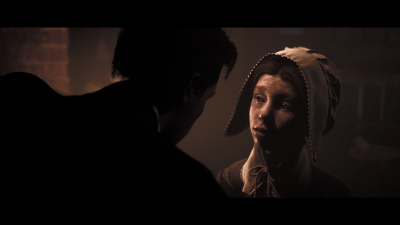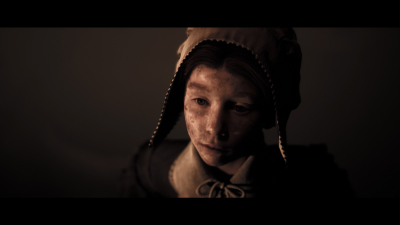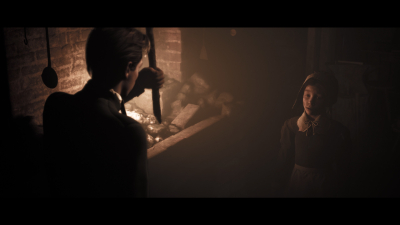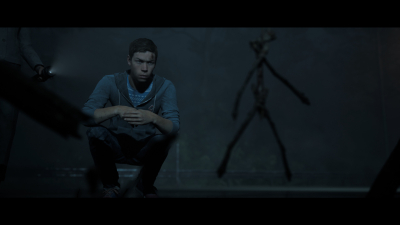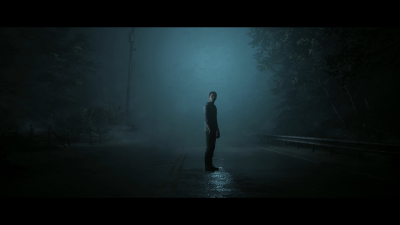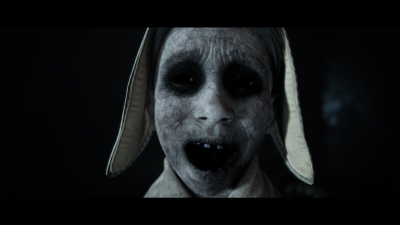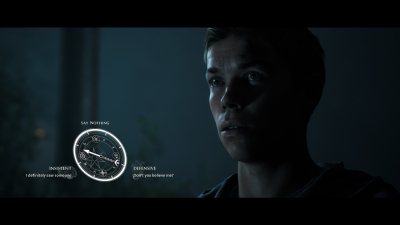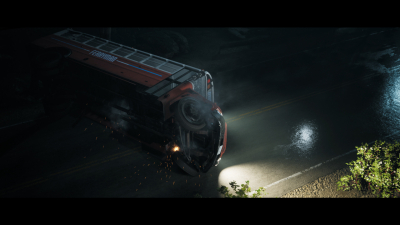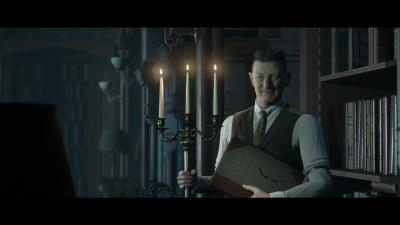Little Hope also leans more toward a movie than a traditional game with its cinematic setting and rudimentary interaction. While you can move freely with the game's various characters in generally very limited areas, making decisions in the sparse dialogue options and examining flashing objects only function as a link between the largely filmed sequences, which are again enhanced with the usual reaction tests in some of the fight and flight sequences. In this case, however, the emphasis is more on overlays and less on the action.
For now, various icons indicate in advance whether you should be prepared to reflexively press a button, or whether moving a targeting cursor will give you an extra challenge in the next section. Tense stealth sequences are also back, where you keep your cool as long as you hit the given impulse with the controller button. On the other hand, examining objects and reading documents helps to better understand the story. As usual, as you explore, you come across pictures or postcards that use visions to give you a glimpse of a possible (and usually deadly) event in the future.
It's about a group of students who, after a bus accident with their teacher, travel to the remote town of Little Hope in search of help and their missing bus driver. It soon becomes clear that something is wrong in this abandoned town with a troubled past: On the one hand, there is a dense and impenetrable fog that pulls the group in a predetermined direction. On the other hand, the protagonists are repeatedly transported to an earlier time by sudden contact with ghostly creatures, when paranoia, superstition, and witch burnings defined the lives of Little Hope's inhabitants, some of whom bear an uncanny resemblance to the students and their teacher.
Conclusion
The storyline, with its Silent Hill-like misty atmosphere, says a bit more than the ghost ship, and I also found the constellation of characters more interesting. The plot, with its little time travels, mysterious doppelgangers, and frighteningly weird creatures, remains exciting until the end, although the shock effects and the overly inflationary suggestion of danger wear a bit thin with time. Also, the effects of some decisions are limited, which is especially noticeable in the second half of the game. It is more important to master the reaction tests interspersed in the life and death struggle, which you can now better prepare for thanks to the new warning. Supermassive Games has also made progress with the character models, although some facial expression transitions are still missing. The controls when exploring limited areas as well as the somewhat choppy animations also need improvement. On the other hand, it's nice that thanks to online cooperation and movie night, you can experience this horror story together once again and even gain more knowledge in the process.
Little Hope also tends more towards a film than a classic game with its cinematic staging and rudimentary interaction. Although you can move freely with the changing game characters in the mostly very limited areas, making decisions in the meager dialog options and examining blinking objects only function as a link between the great movie sequences, which are again enriched with the usual reaction tests in some fight and escape sequences. In this case, however, the focus is more on the overlays and less on what is happening.
From now on, different icons show in advance whether you just have to be prepared for a reflexive button press or an additional challenge by moving a target cursor in the next section. The thrilling stealth sequences are also included again, where you keep calm as long as you hit the given pulse with the controller button. Investigating objects and reading documents, on the other hand, provide important insights into the story. As usual, you stumble across pictures or postcards during the exploration, which provides a glimpse of a possible (and usually deadly) event in the future with visions.
It is about a group of students who, after a bus accident with their professor, go to the remote town of Little Hope to look for help and their missing bus driver. It quickly becomes clear that something is amiss in the gloomy and deserted town with its troubled past: For one thing, there is a dense and impenetrable fog that drives the group along a predetermined path. On the other hand, the protagonists are repeatedly drawn back to an earlier time by sudden touches of ghostly beings, in which paranoia, superstition, and witch burnings determined the lives of the inhabitants of Little Hope, some of whom bear a striking resemblance to the students and their professor.
Conclusion
The scenario with its misty Silent Hill ambiance says a bit more than the ghost ship and the constellation of characters also finds more interesting. The plot with its little time travels, mysterious doppelgangers, and hideously bizarre creatures remains exciting until the end, although shock effects and the too inflationary suggestion of dangers wear a bit thin with time. In addition, the effects of some decisions are limited, which is especially noticeable on the second playthrough. It is more important to master the interspersed reaction tests in the fight for life and death, for which you can now prepare better thanks to the new warning. Supermassive Games has also made progress with the character models, but some facial expression transitions still lack. The controls for exploring the limited areas, along with the somewhat choppy animations, can also be improved. On the other hand, it's nice that you can experience this horror story together again thanks to online co-op and movie night and even gain more knowledge in the process.

